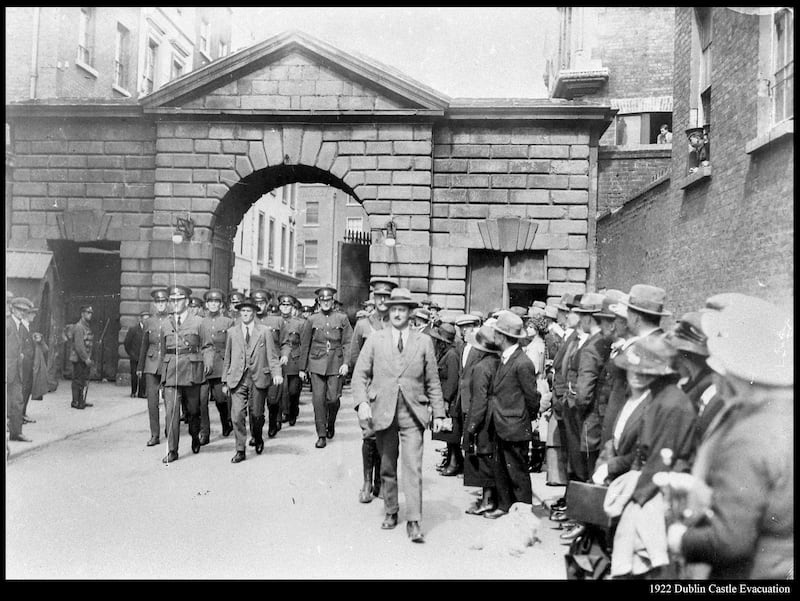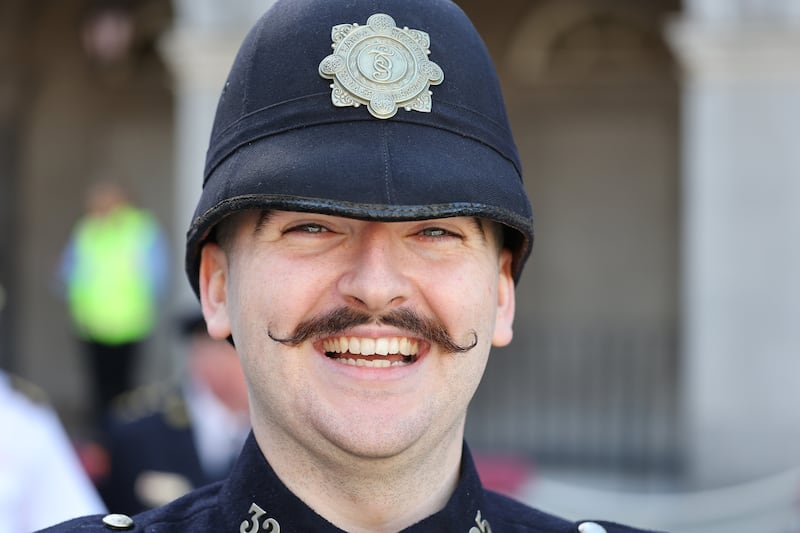Garda Commissioner Drew Harris has said threats to Irish democracy have “not fully dissipated”, as hundreds of gardaí marched into Dublin Castle to mark the centenary of the force.
In a sunlit ceremony attended by 2,000 guests in the upper castle yard, Mr Harris said the force had encountered and responded to difficult periods in Ireland’s past. “Many of us here will remember there was a time, not so long ago in fact, when our democracy was under direct threat. An Garda Síochána was at the forefront of protecting our democracy during those dark days,” he said.
“This threat has not fully dissipated and, of course, there are also now further threats to State security from outside this island. By its nature, this aspect of our work often cannot be discussed in detail or in public at all.”
At the same event on Saturday, Minister for Justice Helen McEntee said the formation of an unarmed national police service amid the chaos of the Civil War “helped to pave the way for stability and confidence” in the new Independent Ireland.
READ MORE

Mr Harris led more than 400 gardaí through the Palace Street entrance at Dublin Castle, emulating the iconic moment in August 1922 when Michael Staines, first commissioner of Civic Guard as it was then, led 440 members of his new force through the castle gates to take command of policing in the nascent Free State.
The castle had been the centre of British rule for centuries. As the new force took charge, the last remaining officers of the RIC left the castle forever via the Ship Street gate. Some RIC men are said to have saluted as the new officers arrived.
On that day in the violent summer of 1922, 60 uniformed members of the Civic Guard were accompanied by 380 recruits in plain clothes. They travelled by train from a training depot at Kildare Artillery Barracks, arriving at the then Kingsbridge station and marching to the castle via the quays, Westmoreland Street, College Green, Dame Street and then Palace Street. Crowds cheered as they passed.

Ms McEntee said the march through the Castle gates “was a hugely symbolic statement of the ability of the newly formed Irish Free State to govern ourselves”. She went on to quote Staines saying An Garda “will succeed, not by force of arms or numbers, but on their moral authority as servants of the people”, describing such remarks as an encapsulation of the good in the force.
While noting garda successes that had greatly benefited society, Mr Harris said there had been times through the decades when the force “did not meet our own high standards or the standards expected of us.” Acknowledging moments when “we could have and should have done better for the Irish people”, he said the force must ensure such mistakes are not repeated. 7
“We must learn the lessons of the past. And because history tells us that it is critical we learn the lessons of the past. We are striving to be even more open and transparent.
The ceremonies, rich in historical resonance, were organised as part of the Decade of Centenaries. Garda flag-bearers were led by Morag Patterson, a Co Longford-based officer whose grandfather Patrick Nolan was one of the first to join the force in 1922 and was among those who accompanied Staines through the castle gates a century ago. Nolan’s registration number was 123.
Guests included former commissioners, retired gardaí and their families and members of the diplomatic community. Former justice ministers Nora Owen and Frances Fitzgerald were there, so too was Peter Kelly, former president of the High Court.
The Garda march on Saturday started from the Gresham Hotel in O’Connell Street, the scene in February 1922 of the first meeting of the “police organising committee” that led to the formation the new force. That meeting, held in secrecy in room 85 of the hotel, was chaired by Michael Collins. Five days after Staines led his men into the castle, Collins was shot dead at Béal na Bláth.
The Garda band led the march down O’Connell Street and D’Olier Street, followed by Mr Harris’s officer marching corps party, the flag party. Among more than 400 gardaí on the march were 89 white-gloved members of the ceremonial unit, one for each of the officers killed in the line of duty.

In her speech, the Minister said the members on the Garda roll of honour were not far from the minds of those at Dublin Castle. “Those 89 men died in the course of going about their work, to the very best of their ability, in the service of the State and the people of Ireland. We will continue to remember and to mourn each of them.”
The march paused by Pearse Street station, known in the time of the Dublin Metropolitan Police as Great Brunswick Street station and once headquarters of the British “G division” intelligence service. It was there during the War of Independence that Ned Broy, a double-agent G division clerk, smuggled Collins in to trawl through secret files for hours. Broy later became the third Garda Commissioner.
The march went on through College Green and Dame Street, clapping crowds drawn by the band’s music, before arriving to applause in the sunlit upper castle yard. The ceremonial unit formed a guard of honour for the Minister’s arrival, which she then inspected, and there was drill display. As the flag party left the yard in silence a Garda siren was briefly heard from the streets outside.
The Garda band and guest musicians played a new piece — An Fórsa Nua — commissioned for ceremony by Odhrán Ó Casaide, a composer who lectures at DIT Conservatory of Music and Drama. This suite in five distinct parts, the first called “Turbulent Times”, was haunting in mood at the start and built gradually to a rousing finish
As the event concluded Ms McEntee and the commissioner turned to face the tricolour for the national anthem, Mr Harris holding his salute until the very end.













